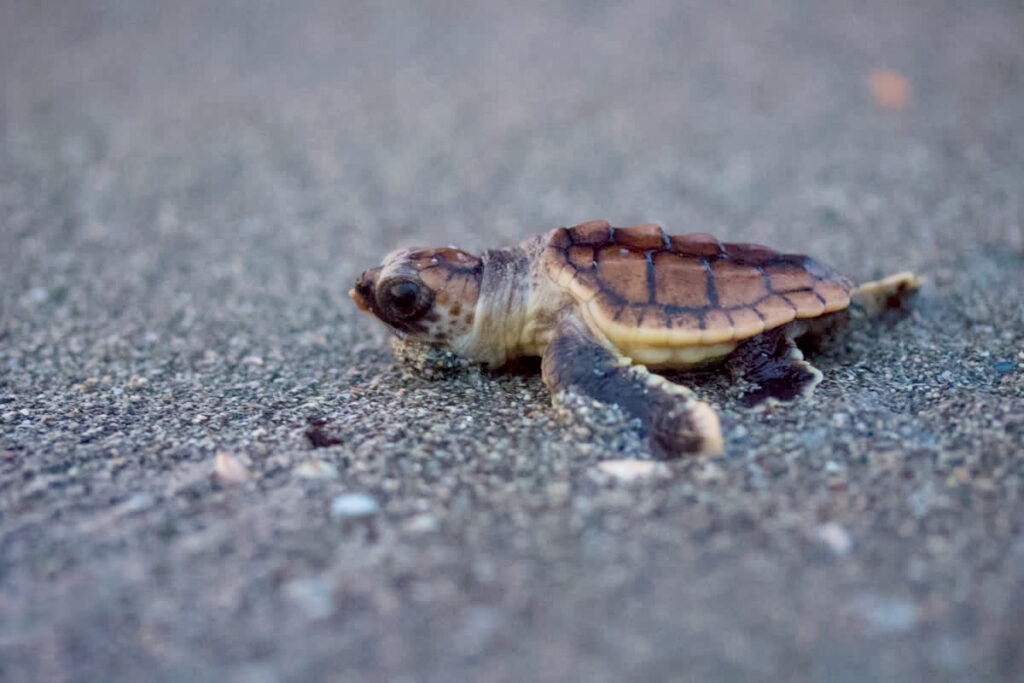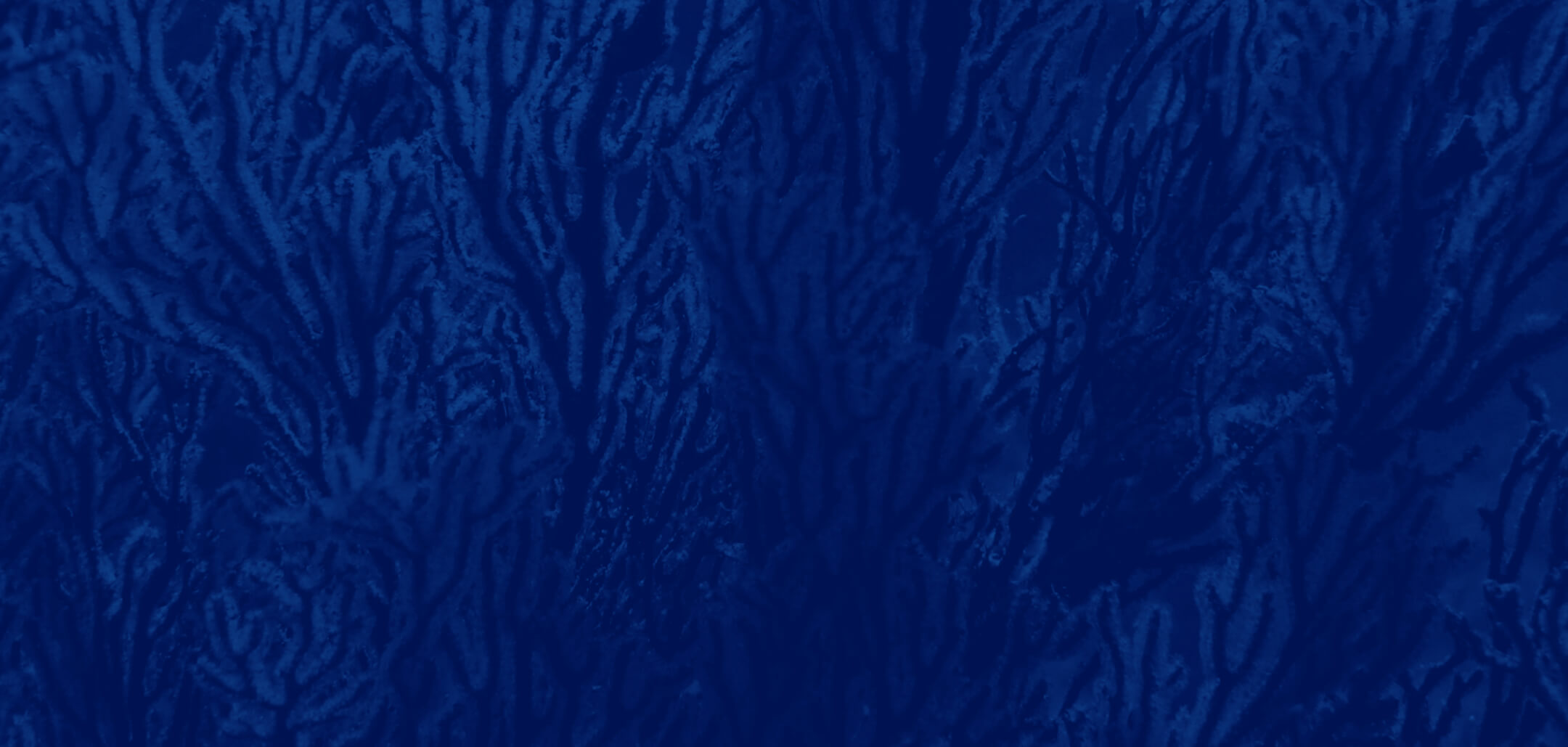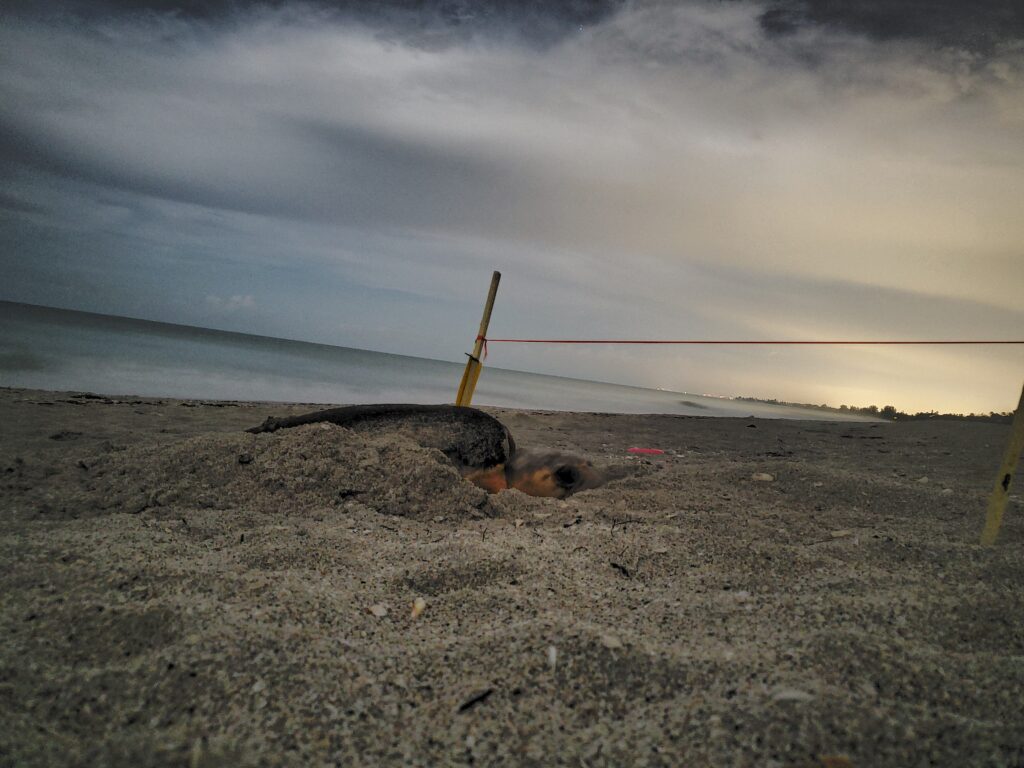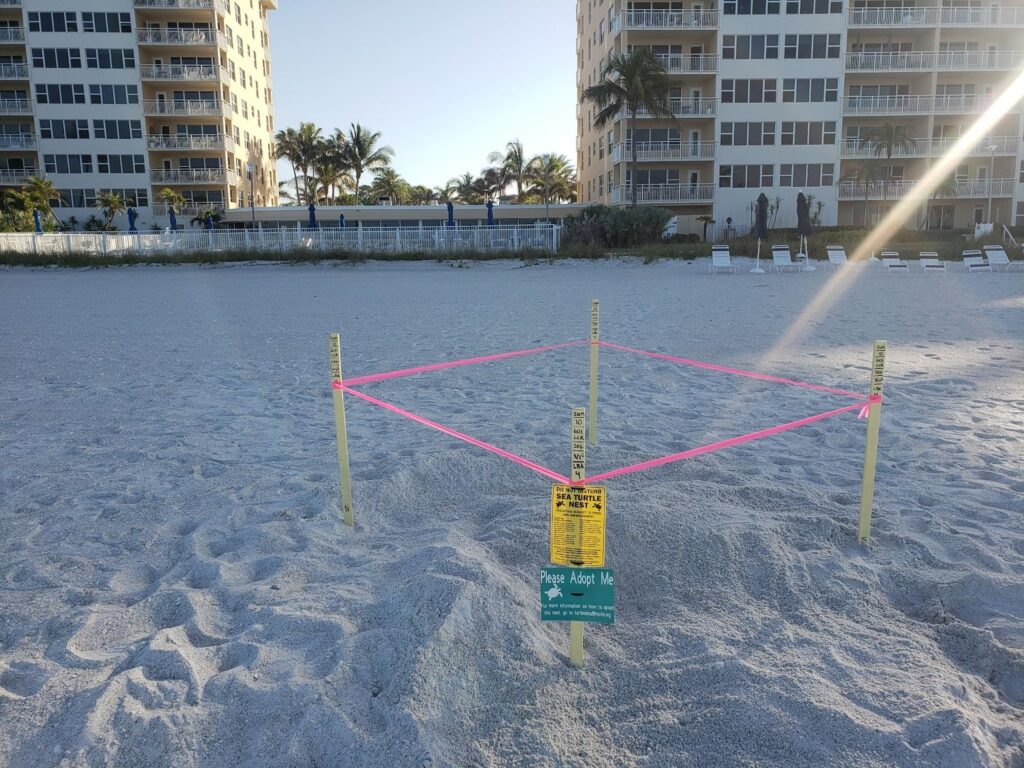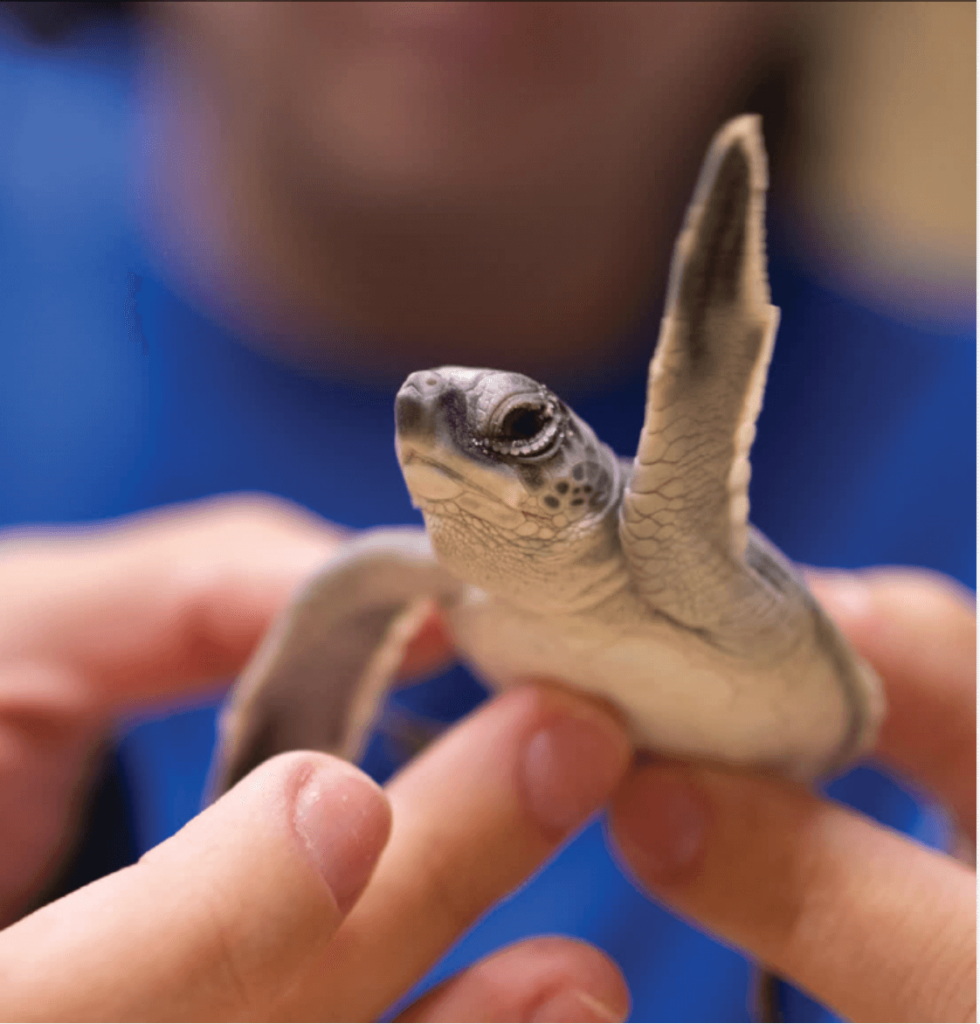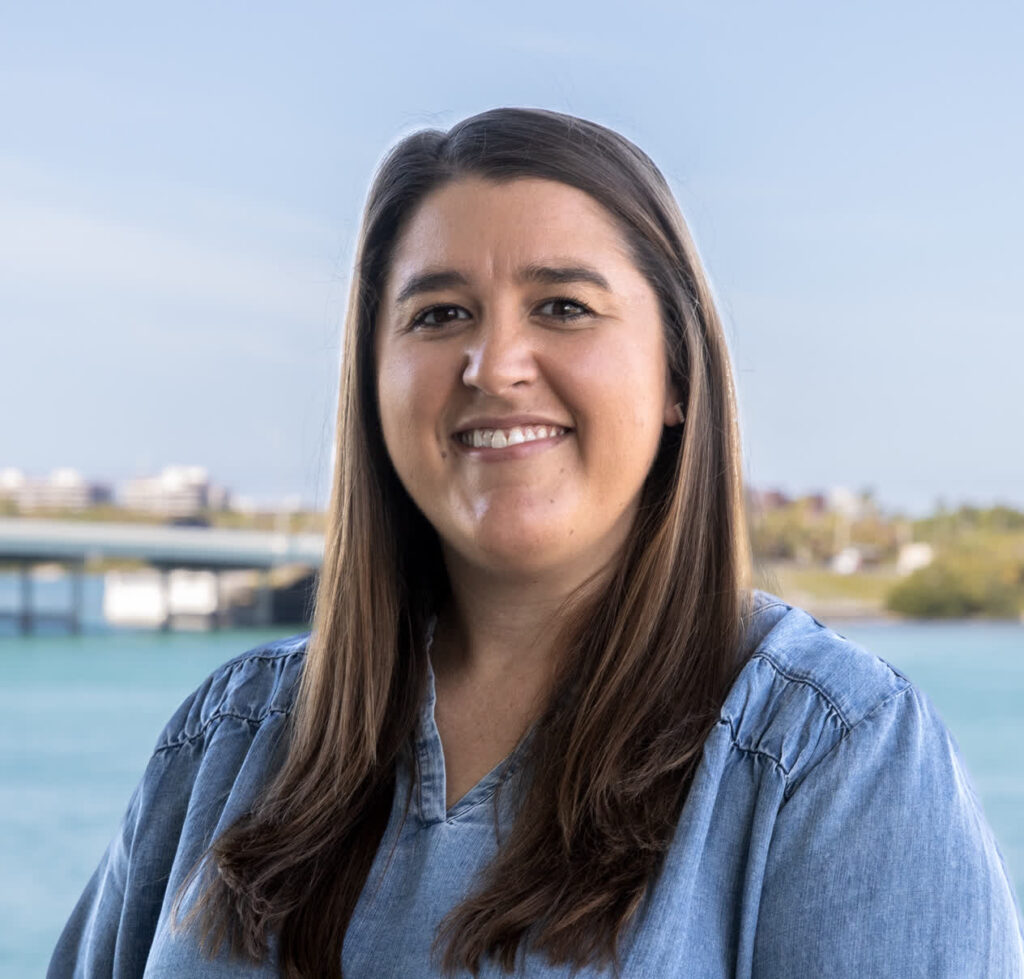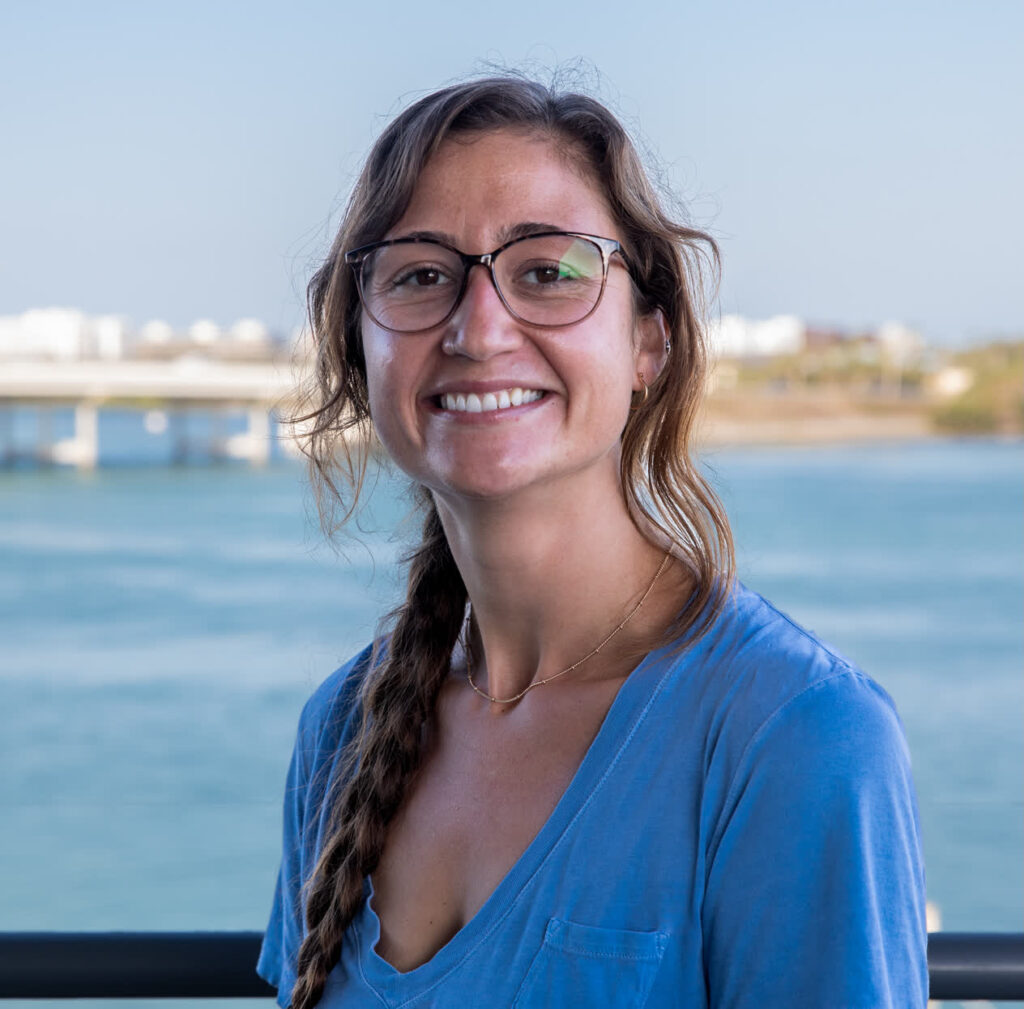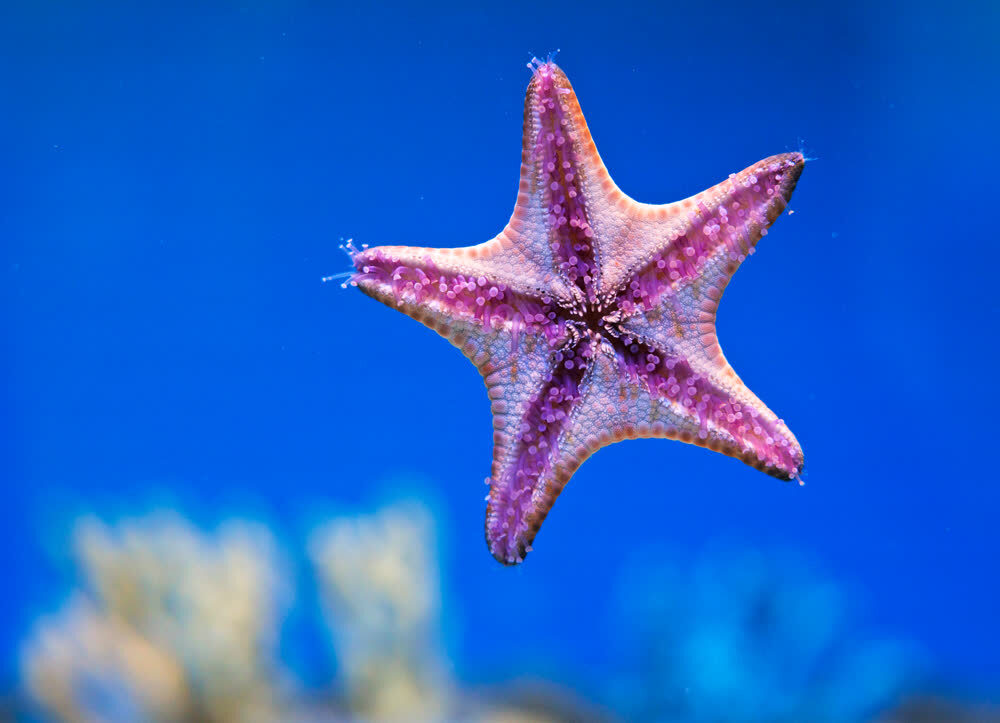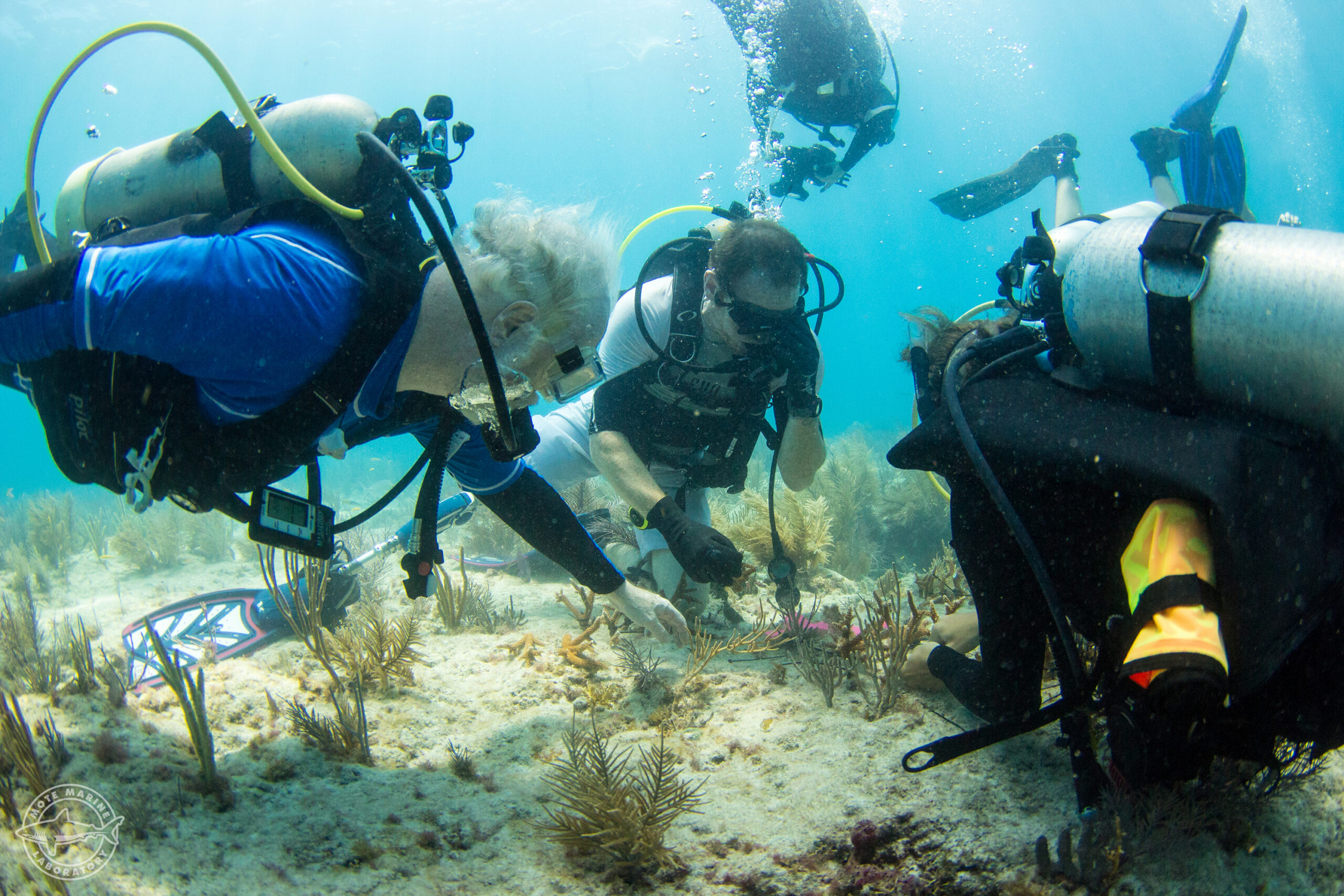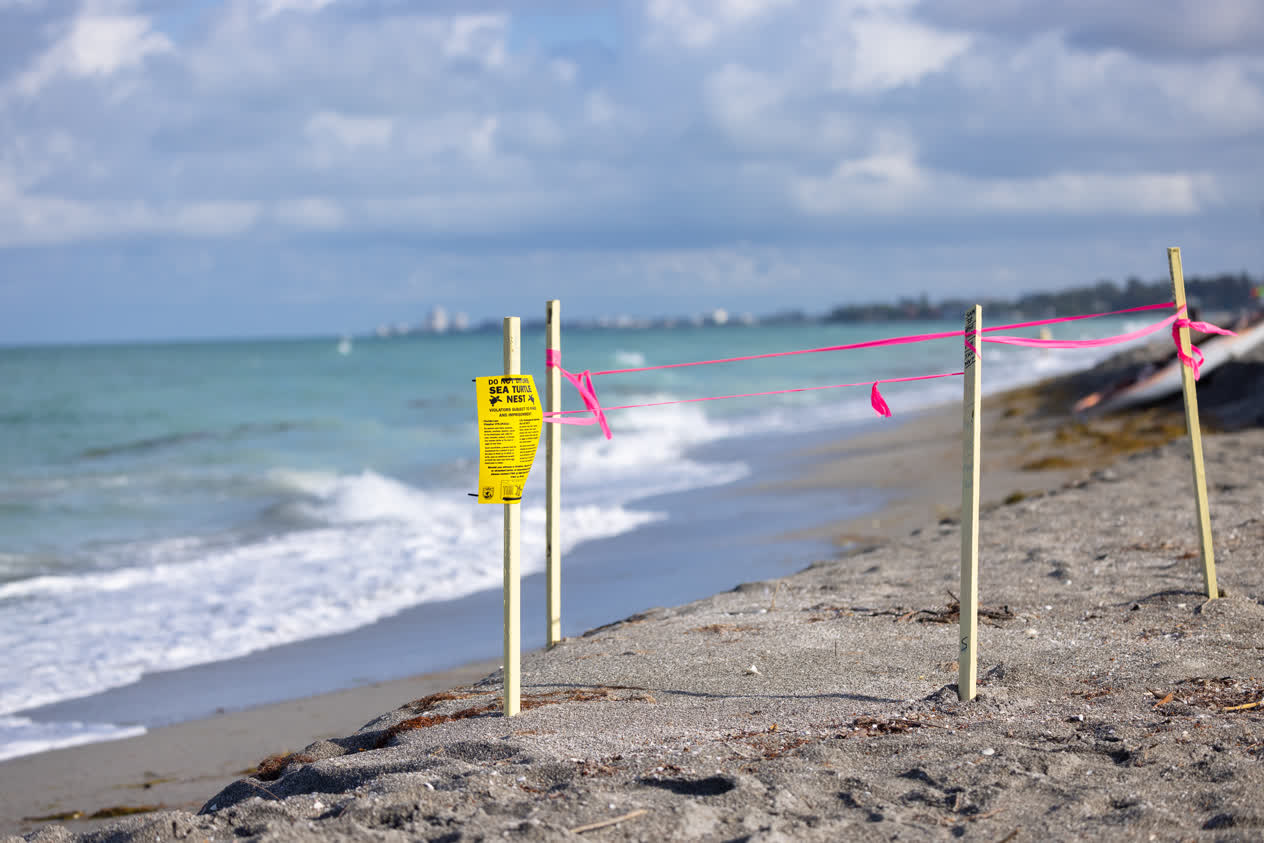
Mote Marine Laboratory’s Sea Turtle Conservation and Research Program (STCRP) has documented sea turtle activities and the status of shoreline habitat along 35 miles of coastline since 1982. This area contains portions of Sarasota and Manatee counties and hosts the highest density of loggerhead sea turtle (Caretta caretta) nests in the Gulf waters.
The program supports conservation of marine turtles through the collection of fundamental biological data about nesting and hatching of sea turtles. Data collected contributes to the overall understanding of nesting trends utilized by local, state, and federal entities.
Program scientists lead research using our long-term datasets and study sea turtles’ natural behavior to quantify how sea turtle nesting populations are adapting over time, help to identify important habitats for sea turtles, and answer critical questions about sea turtle behavior. These findings help us understand how we can reduce the human impacts on nesting beaches and better conserve these keystone species.

Nesting numbers of both loggerhead (Caretta caretta) and green sea turtles (Chelonia mydas) in the region have been growing exponentially since the early 2000s. Annually nests of rare species are also documented, including of Kemp’s ridley (Lepidochelys kempii) and leatherbacks (Dermochelys coriacea).
However, sea turtles still need our help. They face a variety of threats including predator activity on incubating nests and hatchlings, disorientation of females and/or hatchlings due to artificial lighting visible from the beach, interactions with beach furniture, and negative interactions with humans. In the ocean, sea turtles are seeing an increased risk from pollution and boat strikes. Education of the public helps to decrease many of these threats.
We work closely with our communities, educating and encouraging the public to help sea turtles.
Program Details
Mote’s Sea Turtle Conservation & Research Program (STCRP) partners with the Longboat Key Turtle Watch (LBKTW) to monitor nesting beaches on Longboat Key. LBKTW hosts a number of events throughout the year that encourages the public to learn more about sea turtles.
Staff at STCRP work with many researchers across the globe to assess sea turtle behavior.
Scientists and Researchers
- Drs. Beth Brady, Nicole Rhody, Ryan Schlosser, Jeny Toyoda, Cathy Walsh, Mote Marine Laboratory
- Dr. Simona Ceriani, Florida Fish and Wildlife Research Institute
- Kristen Mazzarella, M.S., Anna Maria Island Turtle Watch
- Dr. Justin Perrault and Sarah Hirsh, M.S., Loggerhead Marinelife Center
- Dr. Brian Shamblin, University of Georgia
- Kelly Sloan, M.S., Sanibel Captiva Conservation Foundation
- Dr. Andrea Tarnecki, Auburn University
-
Dr. Christopher Marshall, Texas A&M Galveston
-
Dr. Thane Wibbels, University of Alabama Birmingham
-
Dr. Frank Paladino, Purdue University
- Dr. Jeanette Wyneken, Florida Atlantic University
Partner Organizations
- Florida Fish & Wildlife Conservation Commission
- US Fish & Wildlife Service
- National Oceanic & Atmospheric Administration
- Florida Department of Environmental Protection
- Andy Rosebrock, AXE Inc. Technologies
Mote offers a special thanks to the Sea Turtle Conservancy’s Sea Turtle Grants Program for supporting our research and conservation efforts with numerous grants over the years. Much of our conservation and research was funded (in whole or in part) by grants awarded from the Sea Turtle Grants Program. The Sea Turtle Grants Program is funded from proceeds from the sale of the Florida Sea Turtle License Plate. Learn more at www.helpingseaturtles.org .
 Sea Turtle License Plate Grant, Sea Turtle Conservancy (Awarded 2025) – ATVs for Mote’s Sea Turtle Conservation and Research Program Nesting Survey
Sea Turtle License Plate Grant, Sea Turtle Conservancy (Awarded 2025) – ATVs for Mote’s Sea Turtle Conservation and Research Program Nesting Survey-
Sea Turtle License Plate Grant, Sea Turtle Conservancy (Awarded 2023) – Submeter units for more accurate nest GPS assessment in the Gulf of Mexico
-
Morris Animal Foundation (Awarded 2023) – Are sea turtle nest temperatures impacting mortality on the Gulf of Mexico?
-
Sea Turtle License Plate Grant, Sea Turtle Conservancy (Awarded 2023) – Bacterial Dynamics of Newly Identified Dermatitis in Green Turtles (Chelonia mydas) on Florida’s Gulf Coast
-
Christine Stevens Wildlife Award, Animal Welfare Institute, Using Satellite Telemetry to Study Movement Patterns of Rehabilitated Adult Male Sea Turtles, 2022
- Research Experience for Graduate Students, Mote Marine Laboratory
- Comparing beach temperature profiles on the Gulf of Mexico and their impact on threatened sea turtle primary sex ratios, 2023
- Loggerhead hatchling sex ratios on the Gulf of Mexico and temperature profiles of Sarasota Florida beaches, 2022
- Identifying the effect a geotextile container dune core has on marine turtle nesting in the largest loggerhead nesting aggregation on the Gulf of Mexico. 2020
- National Fish and Wildlife Foundation, 2013
- Sea Turtle License Plate Grant, Sea Turtle Conservancy –
- Bacterial Dynamics of Newly Identified Dermatitis in Green Turtles (Chelonia mydas) on Florida’s Gulf Coast, 2022
- Exclusion analysis an assessment of late season nests to identify breeding sex ratios and productivity of a large and growing nesting aggregation on the Gulf of Mexico, 2021
- Movement patterns and life history parameters of low nesting year green turtles (Chelonia mydas) in the Gulf of Mexico, 2020
- ATVs for Mote’s Sea Turtle Conservation and Research Program Nesting Surveys, 2019
- Integration and Analysis of 37 Years of Nesting and Tagging Data, 2019
- Southwest Florida loggerhead rookeries as long-term collaborative tagging experiment (w/ co-PI J. Foote and D. Addison), 2015
- Matching Funds for GPS Equipment to Pinpoint Turtle Nests Before and After Storms, 2013
- Southwest Florida loggerhead rookeries as a collaborative tagging experiment, 2012
- Assessment of loggerhead turtle habitats that overlap with reef-fish bottom longline fisheries on the West Florida Shelf, Year 2, 2012
- Assessment of nesting site fidelity with geo-positioning archival tags, 2012
- Assessment of loggerhead turtle habitats that overlap with reef-fish bottom longline fisheries on the West Florida Shelf, 2011
- Stable Isotope Profiles of Sea Turtles From the Southwest Rookery, 2010
- Clutch Frequency of Sea Turtles Residing on the Southwest Florida Shelf, Year 2, 2009
- Acoustic Environment of Loggerhead Sea Turtles (Caretta caretta), 2008
- Determination of Intra-season Clutch Frequency for Loggerhead Turtles (Caretta caretta), 2008
- Southwest Florida Loggerhead Rookeries as a Collaborative Tagging Experiment: Wider Use of PIT Tags over Six Years to Improve Estimates of Survivorship, Tag Loss and Nest Site Fidelity, 2008
- Sea Turtle Nest Monitoring and Protection
- Sea Turtle Tagging
- Historic Nesting Behavior
- Temperature Impacts on Sea Turtles
- Hatchling and Breeding Sex Ratios
- Sea Turtle Epibiota
- Green Sea Turtle Dermatitis
- Nourishment and Armoring
- Ecotoxicology of Nesting Sea Turtles
Help Sea Turtles

Sea Turtle Conservation & Research Program Team
Additional Program Information
STCRP takes on NSF REU, Mote URE, and graduate students during the summer to do research projects. STCRP staff and some students present their research findings at conferences including: SICB, GOMCON, JMIH, Herpeton, and ISTS.
Staff members of STCRP have contributed many papers to our understanding of sea turtles and other marine animals, these are a few of the most recent examples:
- Brady B, Sarbacker C, Lasala JA, Maust-Mohl M, Collom KA, Searle L, et al. 2023. Manatees display diel trends in acoustic activity at two microhabitats in Belize. PLoS ONE 18(11): e0294600. https://doi.org/10.1371/journal.pone.0294600
- Ceriani SA, Murasko S, Addison DS, Anderson D, Curry G, Desjardin NA, Eastman SF, Evans DR, Evou N, Fuentes MMPB, Godfrey MH, Hart KM, Hillbrand P, Hirsch SE, Mott CR, Mansfield KL, Mazzarella KT, Norris SV, Pate SM, Phillips KF, Rusenko KW, Shamblin BM, Stevenson A, Sloan KA, Tucker AD, Welsh RC and Casale P. 2023. Monitoring population-level foraging distribution of a marine migratory species from land: strengths and weaknesses of the isotopic approach on the Northwest Atlantic loggerhead turtle aggregation. Front. Mar. Sci. 10:1189661. doi: 10.3389/fmars.2023.1189661
- Lasala JA, Macksey MC, Mazzarella KT, Main KL, Foote JJ, and Tucker AD. 2023. Forty years of monitoring increasing sea turtle relative abundance in the Gulf of Mexico. Scientific Reports, 13: 17213. https://doi.org/10.1038/s41598-023-43651-4
- Lavelle A, Lasala JA, Macksey MC, Koo MS, Spencer CL. 2023. Anthropogenic effects on Loggerhead turtle nest success and predation in the Gulf of Mexico. Herpetological Conservation and Biology, 18(3): 450-463.
- Ramos EA, Brady B, Lasala JA, Liebschner A, Walker SOZ, Rebello M, Magnasco MO. 2023. Antillean manatee calves in captive rehabilitation change vocal behavior in anticipation of feeding. Zoo Biology, 1-7. https://doi.org/10.1002/zoo.21785
- Ferrera A, Formia A, Ciofi C, Natali C, Agyekumhene A, Allman P. 2021. Genetic structure of olive ridley sea turtles (Lepidochelys olivacea) in Ghana, West Africa. Journal of Experimental Marine Biology and Ecology, 544: 151614. https://doi.org/10.1016/j.jembe.2021.151614
- Perrault JR, Lasala JA, Manire CA, Coppenrath CM, Page-Karjian A, Blew A, Stacy NI. 2021. Nonpigmented versus pigmented: health variables and genetics of albino Florida green turtle (Chelonia mydas) hatchlings compared with normally pigmented hatchlings from the same clutch. Journal of Wildlife Diseases, 58: 15-29. https://doi.org/10.7589/JWD-D-21-00031
- Lasala JA, Hughes CR and Wyneken J. 2020. Female loggerhead sea turtles (Caretta caretta L.) rarely remate during nesting season. Ecology and Evolution 10: 163-174.
- Mazzarella KT 2020. Carapace Tag Recaptures from the 1980s. Marine Turtle Newsletter 161:22-23.
- Mazzarella KT, Stacy BA, Kabat LJ and HJ Swanson. 2020. Bacterial Dermatitis Affecting the Carapace of Nesting Green Turtles (Chelonia mydas). Marine Turtle Newsletter 161:24-27.
- Lasala JA, Hughes CR and Wyneken J. 2018. Breeding sex ratio and population size of loggerhead turtles from Southwestern Florida. PLoS One 13:e0191615.
- Schmid JR, Tucker AD. 2018. Comparing diets of Kemp’s ridley sea turtles (Lepidochelys kempii) in mangrove estuaries of Southwest Florida. Journal of Herpetology 52(3): 251-258.
- Tucker AD, Baldwin R, Willson A, Al Kiyumi A, Al Harthi S, Schroeder B, Possard E, and Witherington B. 2018. Revised clutch frequency estimates for Masirah Island loggerhead turtles (Caretta caretta). Herpetological Conservation and Biology 13(1): 158-166.
- Wilson M, Tucker AD, Beedholm K and Mann DA. 2017. Changes of loggerhead turtle (Caretta caretta) dive behavior associated with tropical storm passage during the inter-nesting period. Journal of Experimental Biology 220: 3432-3441.
- Gallaway BJ., WJ Gazey, CW Caillouet, Jr., PT Plotkin, DJ Shaver, FA Abreu Grobois, AF Amos, PM. Burchfield, RR Carthy, MA Castro Martínez, JG Cole, AT Coleman, M Cook, S DiMarco, SP Epperly, M Fujiwara, D Gomez Gamez, GL Graham, WL Griffin, F Illescas Martínez, MM Lamont, RL. Lewison, KJ Lohmann, JM. Nance, J Pitchford, NF Putman, SW Raborn, JK Rester, JJ Rudloe, L Sarti Martínez, M Schexnayder, JR Schmid, C Slay, AD Tucker, M Tumlin, T Wibbels and BM Zapata Najera. 2016. Development of a Kemp’s ridley sea turtle stock assessment model. Gulf of Mexico Science 2016(2): 138-157.
- Vander Zanden HB, Bolten AB, Tucker AD, Hart KM, Lamont MM, Fujisaki I, Addison DS, Mansfield KL, Phillips KF, Pajuelo M, Bjorndal KA.. 2016. Biomarkers reveal sea turtles remained in oiled areas following Deepwater Horizon oil spill. Ecological Applications 26: 2145-2155.
- Kohno S, Bernhard MC, Katsu Y, Zhu J, Bryan TA, Doheny BM, Iguchi T, Guillette Jr LJ. 2015. Estrogen Receptor 1 (ESR1; ERα), not ESR2 (ERβ), Modulates Estrogen-Induced Sex Reversal in the American Alligator, a Species With Temperature-Dependent Sex Determination. Endocrinology, 156(5): 1887-1899. https://doi.org/10.1210/en.2014-1852
- Servis JA, Lovewell G, and Tucker AD. 2015. Diet analysis of subadult Kemp’s ridley (Lepidochelys kempii) turtles from West-Central Florida. Chelonian Conservation and Biology 14: 173-181.
- Ceriani SA, Roth JD, Tucker AD, Evans DR, Addison DS, Sasso SR, Ehrhart LM, and Weishampel JF. 2015. Carry-over effects and foraging ground dynamics of a major loggerhead breeding aggregation. Marine Biology 162: 1955-1968.
- Vander Zanden HB, Tucker AD, Hart KM, Lamont MM, Fujisaki I, Addison DS, Mansfield KL, Phillips KF, Wunder MB, Bowen GJ, Pajuelo M, Bolten AB, Bjorndal KA. 2015. Determining origin in a migratory marine vertebrate: a novel method to integrate stable isotopes and satellite tracking. Ecological Applications 25: 320-335.
- Vander Zanden HB, Tucker AD, Bolten AB, Reich KJ, Bjorndal KA. 2014. Stable isotopic comparison between loggerhead sea turtle tissues. Rapid Communications in Mass Spectrometry 28: 2059-2064.
- Perrault JR, Schmid JR, Walsh CJ, Yordy JE, Tucker AD. 2014. Brevetoxin exposure, superoxide dismutase activity and plasma protein electrophoretic profiles in wild-caught Kemp’s ridley sea turtles (Lepidochelys kempii) in southwest Florida. Harmful Algae 37: 194-202.
- Hardy RF, Tucker AD, Foley AM, Schroeder BA, Giove RJ, Meylan AB. 2014. Spatiotemporal occurrence of loggerhead turtles (Caretta caretta) on the West Florida Shelf and apparent overlap with a commercial fishery. Canadian Journal of Fisheries and Aquatic Sciences 71: 1924-1933. doi 10.1139/cjfas-2014-0128
- Tucker, AD, MacDonald BD, and Seminoff JA. 2014. Foraging site fidelity and stable isotope values of loggerhead turtles tracked in the Gulf of Mexico and Northwest Caribbean. Marine Ecology Progress Series 502: 267-279.
- Epperley SP, Nunes A, Zwartepoorte H, Byrd L, Koperski M, Stokes L, Braganca M, Tucker AD, and Sasso CR. 2013. The repatriation of a Kemp’s ridley from the Eastern Atlantic to the Gulf of Mexico. Marine Turtle Newsletter 136: 1-2.
- Shamblin BM, Bolten AB, Bjorndal KA, Dutton PH, Nielsen JT, Abreu-Grobois FA, Reich KJ, Witherington BE, Bagley DA, Ehrhart LM, Tucker AD, Addison DS, Arenas A, Johnson C, Carthy RR, Lamont MM, Dodd MG, Gaines MS, LaCasella E, Nairn CJ. 2012. Expanded mitochondrial control region sequences increase resolution of stock structure among North Atlantic loggerhead turtle rookeries. Marine Ecology Progress Series 469:145-160.
- Martin KJ, Alessi SC, Gaspard JC, Tucker AD, Bauer GB, and Mann DA. 2012. Underwater hearing in the loggerhead sea turtle (Caretta caretta): comparison of behavioral and auditory evoked potential audiograms. Journal of Experimental Biology 215: 3001-3009.
- Hart KM, Lamont MM, I Fujisake I, Tucker AD, Carthy RR. 2012. Common coastal foraging areas for loggerheads in the Gulf of Mexico: opportunities for marine conservation. Biological Conservation 145:185-194.
- Downes JA, Horner MW, Tucker AD. 2011. Time-geographic density estimation for home range analysis. Annals of GIS 17: 163-171.
- Shamblin BM, Dodd MG, Bagley DA, Ehrhart LM, Tucker AD, Johnson C, Carthy RR, Scarpino R, McMicheal E, Addison DS, Williams KL, Frick MG, Ouellette S, Meylan AB, Godfrey MH, Murphy SR, Nairn CJ. 2011. Genetic structure of the southeastern United States loggerhead turtle nesting aggregation: evidence of additional structure within the peninsular Florida recovery unit. Marine Biology 158: 571-587.
- Tucker AD, Wibbels T, Estes-Layton J. 2010. Radar beacon balls as a recovery aid for field studies. Marine Turtle Newsletter 129:7-9.
- Tucker AD 2010. Nest site fidelity and clutch frequency of loggerhead turtles are better elucidated by satellite telemetry than by nocturnal tagging efforts. Journal of Experimental Marine Biology and Ecology 383:48-55.
- Girard C, Tucker AD, Calmettes B. 2009. Post-nesting migrations of loggerhead sea turtles in the Gulf of Mexico: dispersal in highly dynamic conditions. Marine Biology 156: 1827-1839.
- Tucker AD 2009. Eight nests recorded for a loggerhead turtle within one season. Marine Turtle Newsletter 124: 16-17.
- Welsh R, Tucker AD. 2009. Shifting patterns of nocturnal emergence events for nesting loggerhead turtles (Caretta caretta). Marine Turtle Newsletter 125: 10-12.
- Wyneken J, Madrak, SV, Salmon M, Foote J. 2009. Migratory activity by hatchling loggerhead sea turtles (Caretta caretta L.): evidence for divergence between nesting groups . Marine Biology 156(2):171-178.
- Yeiser BG, Morris JJ, Tucker AD. 2008. Caretta caretta (loggerhead turtle). Predation. Herpetological Review 39: 343-344.
- Barleycorn A, Tucker AD. 2005. Lepidochelys kempii diet. Herpetological Review 36: 58-59.

